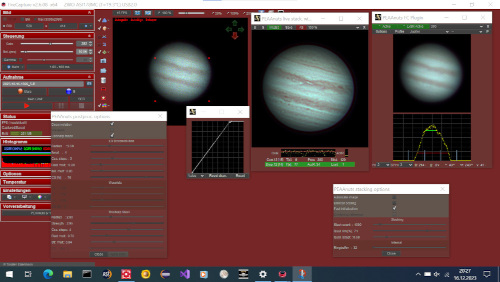



|
In the late 70s, my interest in astronomy was triggered by a glimpse at Saturn through
a small telescope of a neighbour. My parents were afraid of me becoming a nerd, and tried their best
to prevent that, without much success, though :-). Observing the planets
quickly became a focus of my astronomical interest. In the course of time, my activity paused
for several decades. In the recent years, I returned to the place behind the telescope again.
But things have changed dramatically. Now, in the era of digital imaging and processing,
one spends more time in front of the computer than behind the telescope.
All images shown here are taken with a 6" ED Apo refracting telescope, which is a rather modest equipment compared to the 10",12" and 14" optics used by many others. But with appropriate image processing, still a lot of interesting phenomena can be captured. |

|

|

|

|

|
||||||||||||||||||||||||||||||||||
|
Using digital cameras and mathematical image processing methods is the current state of the art in
planetary imaging. A very versatile and widespreadly used recording software is FireCapture
One of FireCaptures unique strongpoints is the plugin interface, which opens the way for other developers to write addons and
modules for various forms of immediate data processing after reading them from the camera.
The PEAAnuts module is such a plugin which performs immediate stacking and sharpening and thus can provide a live detail view of the recorded data which otherwise needs to be produced in a time consuming work with separate programs after recording. Besides that, it offers a stream preview and analysis which is helpful for focusing and other tasks for quantifying data quality. Of course, live processing has to proceed quickly, so usually, the resulting quality might not fully reach the level which can be achieved with processing a recorded stream afterwards with more elaborate, but time consuming methods. The topic is quite similar to the difference between EAA previews and extensively postprocessed high resolution images in deep sky imaging. For deep sky observation, live stacking programs are available already since a couple of years. The PEAAnuts plugin now closes the gap on the side of planetary imaging. The actual version is a prerelease. It is not yet fully complete in terms of the feature set which was planned for the initial release. But it has already reached a "close to ready" state, and can be used in a very productive way in its current state. Many of the planet images shown here have been produced with help of the plugin. Therefore the decision was made to offer this prerelease for interested observers for experimenting and testing. Note again that this is a plugin, so it cannot operate standalone. You need an actual installation of FireCapture as a basis. The download archive contains the plugin module (Java .jar file) and a separately zipped manual in html format. So after unpacking the archive, (Linux users may use 7z for opening .zip files) you will see two subfolders with plugins ('peaanuts.jar'), for FC 2.7.xx or the old FC 2.6.xx, and another zip ('peaanuts_manual_v100wip[n].zip'), where the [n] denotes the prerelease version number. Extract this zip to a place of your choice, then point your browser to the start file "../peaanuts_manual_v100wip[n]/PEAAnuts_Manual.html." PLEASE read the manual, it contains all information you need for installation and working with the plugin. During the prelease state, the common version number frenzy is reduced to a minimum, the 'work in progress' releases will just be numbered consecutively, peaanuts_v1.0.0wip1, peaanuts_v1.0.0wip2, ... and so on You may use the software for private, non-commercial purposes, but it comes with no warranty. The author accepts no liability for any kind of damage resulting from use of the software. Download: peaanuts_v100wip10.zip sha256 checksum: f12f30bc5b558ef615172c4d1c214c361168abacede1f4dc15ae5c4ba22082e1 |

Screenshot of a FireCapture session with PEAAnuts plugin. |
|||||||||||||||||||||||||||||||||
| Version history | ||||||||||||||||||||||||||||||||||
|
||||||||||||||||||||||||||||||||||

|
||||||||||||||||||||||||||||||||||
| --> Imprint / Impressum | --> Privacy Statement / Datenschutzerklärung | --> Contact |

|
||